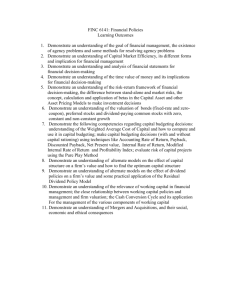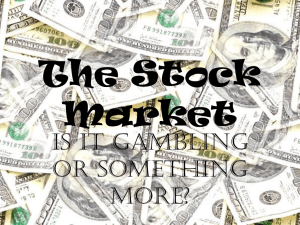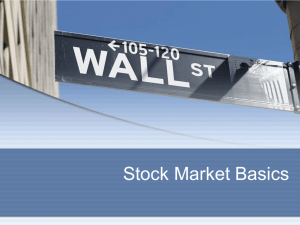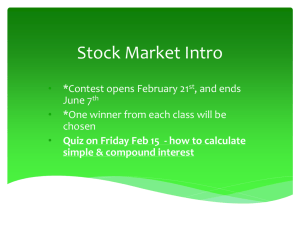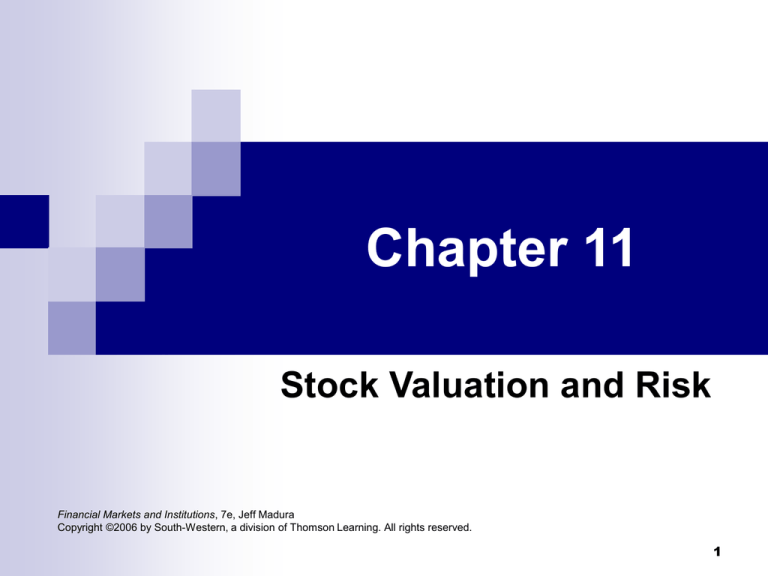
Chapter 11
Stock Valuation and Risk
Financial Markets and Institutions, 7e, Jeff Madura
Copyright ©2006 by South-Western, a division of Thomson Learning. All rights reserved.
1
Chapter Outline
Stock valuation methods
Determining the required rate of return to value stocks
Factors that affect stock prices
Role of analysts in valuing stocks
Stock risk
Applying value at risk
Forecasting stock price volatility and beta
Stock performance measurement
Stock market efficiency
Foreign stock valuation, performance, and efficiency
2
Stock Valuation Methods
The price-earnings (PE) method assigns the
mean PE ratio based on expected earnings of
all traded competitors to the firm’s expected
earnings for the next year
Assumes
future earnings are an important
determinant of a firm’s value
Assumes that the growth in earnings in future years
will be similar to that of the industry
3
Stock Valuation Methods (cont’d)
Price-earnings (PE) method (cont’d)
Reasons for different valuations
Investors may use different forecasts for the firm’s earnings
or the mean industry earnings
Investors disagree on the proper measure of earnings
Limitations of the PE method
May result in inaccurate valuation for a firm if errors are
made in forecasting future earnings or in choosing the
industry composite
Some question whether an investor should trust a PE ratio
4
Valuing A Stock Using the PE
Method
A firm is expected to generate earnings of $2 per
share next year. The mean ratio of share price
to expected earnings of competitors in the
same industry is 14. What is the valuation of
the firm’s shares according to the PE method?
Valuation per share (Expected earnings of firm per share) (Mean industry PE ratio)
$2 14 $28
5
Stock Valuation Methods (cont’d)
Dividend discount model
John
Williams (1931) stated that the price of a stock
should reflect the present value of the stock’s future
dividends:
k
Dt
Price
t
(
1
k
)
t 1
D can be revised in response to uncertainty about the
firm’s cash flows
k can be revised in response to changes in the required
rate of return by investors
6
Stock Valuation Methods (cont’d)
Dividend discount model (cont’d)
For
a constant dividend, the cash flow is a
perpetuity:
Price
Dt
D
t
k
t 1 (1 k )
For
a constantly growing dividend, the cash flow
is a growing perpetuity:
Price
Dt
D1
t
k g
(
1
k
)
t 1
7
Valuing A Stock Using the
Dividend Discount Model
Example 1: A firm is expected to pay a dividend
of $2.10 per share every year in the
foreseeable future. Investors require a return
of 15% on the firm’s stock. According to the
dividend discount model, what is a fair price
for the firm’s stock?
Price
Dt
D $2.10
$14
t
k
15%
t 1 (1 k )
8
Valuing A Stock Using the
Dividend Discount Model
Example 2: A firm is expected to pay a dividend
of $2.10 per share in one year. In every
subsequent year, the dividend is expected to
grow by 3 percent annually. Investors
require a return of 15% on the firm’s stock.
According to the dividend discount model,
what is a fair price for the firm’s stock?
Dt
D1
$2.10
Price
$17.50
t
k g 15% 3%
t 1 (1 k )
9
Stock Valuation Methods (cont’d)
Dividend discount model (cont’d)
Relationship
between dividend discount model
and PE ratio
The PE multiple is influenced by the required rate of
return and the expected growth rate of competitors
The inverse relationship between required rate of return
and value exists in both models
The positive relationship between a firm’s growth rate
and its value exists in both models
10
Stock Valuation Methods (cont’d)
Dividend discount model (cont’d)
Limitations
Errors can be made in determining the:
of the dividend discount model
Dividend to be paid
Growth rate
Required rate of return
Errors are more pronounced for firms that retain most of
their earnings
11
Stock Valuation Methods (cont’d)
Adjusting the dividend discount model
The
value of the stock is:
The PV of the future dividends over the investment
horizon
The PV of the forecasted price at which the stock will be
sold
Must estimate the firm’s EPS in the year they plan to sell
the stock by applying an annual growth rate to the
prevailing EPS
12
Using the Adjusted Dividend
Discount Model
Parker Corp. currently has earnings of $10 per
share. Investors expect that the EPS will
growth by 3 percent per year and expect to
sell the stock in four years. What is the EPS
in four years?
Forecasted earnings in n years E (1 G )n
$10 (1.03 )4 $11.26
13
Using the Adjusted Dividend
Discount Model (cont’d)
Other firms in Parker’s industry have a mean PE
ratio of 7. What is the estimated stock price in
four years?
Stock price in 4 years (Earnings in 4 years) (PE ratio of industry)
$11.26 7 $78.82
14
Using the Adjusted Dividend
Discount Model (cont’d)
Parker is expected to pay a dividend of $2 per
share over the next four years. Investors
require a return of 13% on their investment.
Based on this information, what is a fair value
of the stock according to the adjusted
dividend discount model?
$2
$2
$2
$2
$78.82
(1.13)1 (1.13)2 (1.13)3 (1.13)4 (1.13)4
$54.29
PV
15
Stock Valuation Methods (cont’d)
Adjusting the dividend discount model
(cont’d)
Limitations
of the adjusted dividend discount
model
Errors can be made in deriving the PV of dividends over
the investment horizon or the forecasted price at which
the stock can be sold
Errors can be made if an improper required rate of
return is used
16
Determining the Required Rate of
Return to Value Stocks
The capital asset pricing model:
Assumes
that the only important risk is systematic
risk
Is not concerned with unsystematic risk
Suggests that the return on an asset is influenced
by the prevailing risk-free rate, the market return,
and the covariance between a stock’s return and the
market’s return:
R j Rf B j (Rm Rf )
17
Determining the Required Rate of
Return to Value Stocks (cont’d)
The capital asset pricing model (cont’d)
Estimating the risk-free rate and the market risk premium
The yield on newly issued T-bonds is commonly used as a proxy
for the risk-free rate
The terms within the parentheses measure the market risk
premium
Historical data over 30 or more years can be used to determine
the average market risk premium over time
Estimating the firm’s beta
Beta reflects the sensitivity of the stock’s return to the market’s
overall return
Beta is typically measured with monthly or quarterly data over the
last four years or so
18
Using the CAPM
Fantasia Corp. has a beta of 1.7. The prevailing
risk-free rate is 5% and the market risk
premium is 5%. What is the required rate of
return of Fantasia Corp. according to the
CAPM?
R j Rf B j ( R m Rf )
5% 1.7(10% 5%)
13.5%
19
Determining the Required Rate of
Return to Value Stocks (cont’d)
The capital asset pricing model (cont’d)
Limitations of the CAPM
A study by Fama and French found that beta is unrelated to
the return on stock over the 1963–1990 period
Chan and Lakonishok:
Found that the relation between stock returns and beta
varied with the time period used
Concluded that it is appropriate to question whether beta is
the driving force behind stock returns
Found that firms with the highest betas performed much
worse than firms with low betas
Found that high-beta firms outperformed low-beta firms
during market upswings
20
Determining the Required Rate of
Return to Value Stocks (cont’d)
Arbitrage pricing model
Suggests
that a stock’s price can be influenced by a
set of factors in addition to the market
e.g., economic growth, inflation
In
equilibrium, expected returns on assets are
linearly related to the covariance between assets
returns and the factors:
E (R ) B0
m
B F
i
i
i 1
21
Factors That Affect Stock Prices
Economic factors
Impact
An increase in economic growth increases expected cash
flows and value
Indicators such as employment, GDP, retail sales, and
personal income are monitored by market participants
Impact
of economic growth
of interest rates
Given a choice of risk-free Treasury securities or stocks,
stocks should only be purchased if they offer a sufficiently
high expected return
22
Factors That Affect Stock Prices
(cont’d)
Economic factors (cont’d)
Impact
of the dollar’s exchange rate value
The value of the dollar affects U.S. stocks because:
Foreign investors purchase U.S. stocks when the dollar is
weak
Stock prices are affected by the impact of the dollar’s
changing value on cash flows
Some U.S. firms are involved in exporting
U.S.-based MNCs have some earnings in foreign currencies
Exchange rates may affect expectations of other economic
factors
23
Factors That Affect Stock Prices
(cont’d)
Market-related factors
Investor sentiment
In some periods, stock market performance is not highly
correlated with existing economic conditions
Stocks can exhibit excessive volatility because their prices are
partially driven by fads and fashions
A study by Roll found that only one-third of the variation in stocks
returns can be explained by systematic economic forces
January effect
Many portfolio managers invest in riskier small stocks at the
beginning of the year and shift to larger companies near the end
of the year
Places upward pressure on small stocks in January
24
Factors That Affect Stock Prices
(cont’d)
Firm-specific factors
Some firms are more exposed to conditions within their own
industry than to general economic conditions, so participants
monitor:
Industry sales forecasts
Entry into the industry by new competitors
Price movements of the industry’s products
Market participants focus on announcements that signal
information about a firm’s sales growth, earnings, or
characteristics that cause a revision in the expected cash flows
25
Factors That Affect Stock Prices
(cont’d)
Firm-specific factors (cont’d)
Dividend policy changes
Earnings surprises
When a firm’s announced earnings are higher than expected,
investors may raise their estimates of the firm’s future cash flows
Acquisitions and divestitures
An increase in dividends may reflect the firm’s expectation that it
can more easily afford to pay dividends
Expected acquisitions typically result in an increased demand for
the target’s stock and raise the stock price
The effect on the acquiring firm is less clear
Expectations
Investors attempt to anticipate new policies so they can make
their move before other investors
26
Factors That Affect Stock Prices
(cont’d)
Integration of factors affecting stock prices
Whenever
economic indicators signal the
expectation of higher interest rates, there is upward
pressure on the required rate of return
Firms’ expected future cash flows are influenced by
economic conditions, industry conditions, and firmspecific conditions
27
Role of Analysts in Valuing Stocks
Many investors rely on opinions of stock analysts
employed by securities firms or other financial firms
Many analysts are assigned to specific stocks and
issue ratings that can indicate whether investors
should buy or sell the stock
A 2001 study by Thomson Financial determined that
analysts at the largest brokerage firms typically
recommended “sell” for less than 1 percent of all the
stocks for which they provided ratings
28
Role of Analysts in Valuing Stocks
(cont’d)
Conflicts of interest
Many analysts are employed by securities firms that have other
investment banking relationships with rated firms
Some analysts may own the stock of some of the firms they rate
Impact of disclosure regulations
In October 2000, the SEC enacted Regulation FD, which requires
firms to disclose any significant information simultaneously to all
market participants
Unbiased analyst rating services
Popular rating services include Morningstar, Value Line, and
Investor’s Business Daily
Analyst rating services typically charge subscribers between $100
and $600 per year
29
Stock Risk
Risk reflects the uncertainty about future returns such
that the actual return may be less than expected
The holding period return is measured as:
(SP INV ) D
R
INV
The main source of uncertainty is the price at which the stock
can be sold
Dividends tend to be much more stable than stock price
30
Stock Risk (cont’d)
Measures of risk
The
volatility of a stock:
May indicate the degree of uncertainty surrounding the
stock’s future returns
Reflects total risk because it reflects movements in stock
prices for any reason
31
Stock Risk (cont’d)
Measures of risk (cont’d)
The
volatility of a stock portfolio depends on:
The volatility of the individual stocks in the portfolio
The correlations between returns of the stocks in the
portfolio
The proportion of total funds invested in each stock
A portfolio containing some stocks with low or negative
correlation will exhibit less volatility
p w i2 i2 w 2j 2j 2w i w j i j CORRij
32
Stock Risk (cont’d)
Measures of risk (cont’d)
The
beta of a stock:
Measures the sensitivity of its returns to market returns
Is used by many investors who have a diversified portfolio
of stocks
Can be estimated by obtaining returns of the firm and the
stock market and applying regression analysis to derive the
slope coefficient:
R jt B0 B1Rmt ut
33
Stock Risk (cont’d)
Measures of risk (cont’d)
The
beta of a stock portfolio:
Is useful for investors holding more than one stock
Can be measured as a weighted average of the betas of
stocks in the portfolio, with the weights reflecting the
proportion of funds invested in each stock:
Bp
w B
i
i
The risk of a high-beta portfolio can be reduced by replacing
some of the high-beta stocks with low-beta stocks
34
Stock Risk (cont’d)
Measures of risk (cont’d)
Value at risk:
Is a risk measurement the estimates the largest expected loss to
a particular investment position for a specified confidence level
Became very popular in the late 1990s after some mutual funds
and pension funds experienced abrupt large losses
Is intended to warn investors about the potential maximum loss
that could occur
Focuses on the pessimistic portion of the probability distribution of
returns
Is commonly used to measure the risk of a portfolio
35
Applying Value at Risk
Methods of determining the maximum
expected loss
Use
of historical returns to derive the maximum
expected loss
e.g., an investor may determine that out of the last 100
trading days, a stock experienced a decline of greater than
7 percent on 5 different days
The investor could infer a maximum daily loss of no more
than 7 percent for that stock based on a 95 percent
confidence level
36
Applying Value at Risk (cont’d)
Methods of determining the maximum
expected loss (cont’d)
Use
of standard deviation to derive the maximum
expected loss
The standard deviation of daily returns over the previous
period can be used and applied to derive boundaries for a
specific confidence level
Use
of beta to derive the maximum expected loss
37
Using the Standard Deviation to
Derive the Maximum Expected Loss
The standard deviation of daily returns for a
stock in a recent period is 1%. The 95%
confidence level is desired for the maximum
loss. The stock has an expected daily return
of .1%. What is the lower boundary of
expected returns?
.1% 1.65 (1%) 1.55%
38
Using Beta to Derive the Maximum
Expected Loss
A stock’s beta over the last 100 days is 1.3. The
stock market is expected to perform no worse
than –2.1% on a daily basis based on a 95%
confidence level. What is the maximum loss
to the stock over a given day based on this
information?
1.3 ( 2.1%) 2.73%
39
Applying Value at Risk (cont’d)
Deriving the maximum dollar loss
The maximum percentage loss for a given confidence level
can be applied to derive the maximum dollar loss of a
particular investment
Value at risk is commonly applied to assess the maximum
possible loss for an entire portfolio
Common adjustments to value at risk applications
Investment horizon desired
Length of historical period used
Time-varying risk
Restructuring the investment portfolio
40
Forecasting Stock Price Volatility
and Beta
Methods of forecasting stock price volatility
The historical method uses a historical period to derive a
stock’s standard deviation of returns and uses that estimate as
the forecast for the future
The time-series method uses volatility patterns in previous
periods
Places more weight on the most recent data
Normally uses the weights and number of periods that were the
most accurate in previous periods
The implied standard deviation derives the estimate from the
stock option pricing model
Represents the anticipated volatility of the stock over a future
period by investors trading the stock
41
Forecasting Stock Price Volatility
and Beta (cont’d)
Forecasting a stock portfolio’s volatility
Portfolio
volatility can be forecast by first deriving
forecasts of individual volatility levels
Next, the correlation coefficient for each pair of
stock in the portfolio is forecast by estimating the
correlation in recent periods
Forecasting a stock portfolio’s beta
First
forecast the betas of the individual stocks and
then take a weighted average
42
Stock Performance Measurement
The Sharpe index is appropriate when total variability
is thought to be the appropriate measure of risk:
Sharpe index
R Rf
The higher the stocks’ mean return relative to the mean riskfree rate and the lower the standard deviation, the higher the
Sharpe index
Measures the excess return above the risk-free rate per period
43
Using the Sharpe Index
Patrick stock has an average return of 15% and
an average standard deviation of 13%. The
average risk-free rate is 8%. What is the
Sharpe index for Patrick stock?
Sharpe index
R Rf
15% 8%
0.54
13%
44
Stock Performance Measurement
(cont’d)
The Treynor index is appropriate when beta is
thought to be the most appropriate type of risk:
R Rf
Treynor index
B
The
higher the Treynor index, the higher the return
relative to the risk-free rate, per unit of risk
45
Using the Treynor Index
Patrick stock has an average return of 15% and
a beta of 1.8. The average risk-free rate is
8%. What is the Sharpe index for Patrick
stock?
R Rf
Treynor index
B
15% 8%
0.04
1 .8
46
Stock Market Efficiency
Forms of efficiency
Weak-form efficiency suggests that security prices reflect all
trade-related information
Semistrong-form efficiency suggests that security prices fully
reflect all public information
Includes announcements by firms, economic news or events, and
political news or events
If semistrong-form efficiency holds, weak-form efficiency holds as
well
Strong-form efficiency suggests that security prices fully reflect
all information, including private or insider information
47
Stock Market Efficiency (cont’d)
Tests of the efficient market hypothesis
Test of weak-form efficiency
Tested by searching for a nonrandom pattern in security
prices
Studies have generally found that historical price changes
are independent over time
There is some evidence that stocks:
Have performed better in January (January effect)
Have performed better on Fridays than on Mondays
(weekend effect)
Have performed well on the trading days just before holidays
(holiday effect)
48
Stock Market Efficiency (cont’d)
Tests of the efficient market hypothesis
Test of semistrong-form efficiency
Tested by assessing how security returns adjust to particular
announcements
Generally, security prices immediately reflect the information from
announcements
There is evidence of unusual profits from investing in IPOs
Test of strong-form efficiency
Difficult to test
There is evidence that share prices of target firms rise
substantially when the acquisition is announced
Insiders are discouraged from using inside information because it
is illegal
49
Foreign Stock Valuation,
Performance, and Efficiency
Valuation of foreign stocks
PE method
The expected EPS of the foreign firm are multiplied by the
appropriate PE ratio based on the firm’s risk and local industry
The PE ratio for a given industry may change continuously in
some foreign markets
The PE ratio for a particular industry may need to be adjusted for
the firm’s country
Dividend discount model
An adjustment for expected exchange rate movements is required
The value of foreign stocks from a U.S. perspective is subject to
more uncertainty than the value of the stock from a local
investor’s perspective
50
Foreign Stock Valuation, Performance,
and Efficiency (cont’d)
Measuring performance from investing in
foreign stocks
The
performance measurement should control for
general market movements and exchange rate
movements in the region where the portfolio
managers has been assigned to invest funds
51
Foreign Stock Valuation, Performance,
and Efficiency (cont’d)
Performance from global diversification
Stock
investors can benefit by diversifying
internationally
Economies do not move in tandem
Stock markets across countries may respond to some of
the same expectations
In general, correlations between stock indexes have been
higher in recent years than they were several years ago
52
Foreign Stock Valuation, Performance,
and Efficiency (cont’d)
Performance from global diversification (cont’d)
Integration of markets during the 1987 crash
Integration of markets during mini-crashes
There was a high correlation among country stock markets during
the crash
This suggests that the underlying cause of the crash
systematically affected all markets
On August 27, 1998 (“Bloody Thursday”) most stock markets
around the world experienced losses
Illustrates that even a well-diversified international portfolio is not
insulated from some events
Diversification among emerging stock markets
These markets have lower correlations with developed countries,
but also higher risk
53
Foreign Stock Valuation, Performance,
and Efficiency (cont’d)
International market efficiency
Some
foreign markets are inefficient because of the
small number of analysts and portfolio managers
Market inefficiencies are more common in small
foreign stock markets
Insider trading is more prevalent in many foreign
markets
Political and exchange rate risk may be high in
some foreign markets
54



